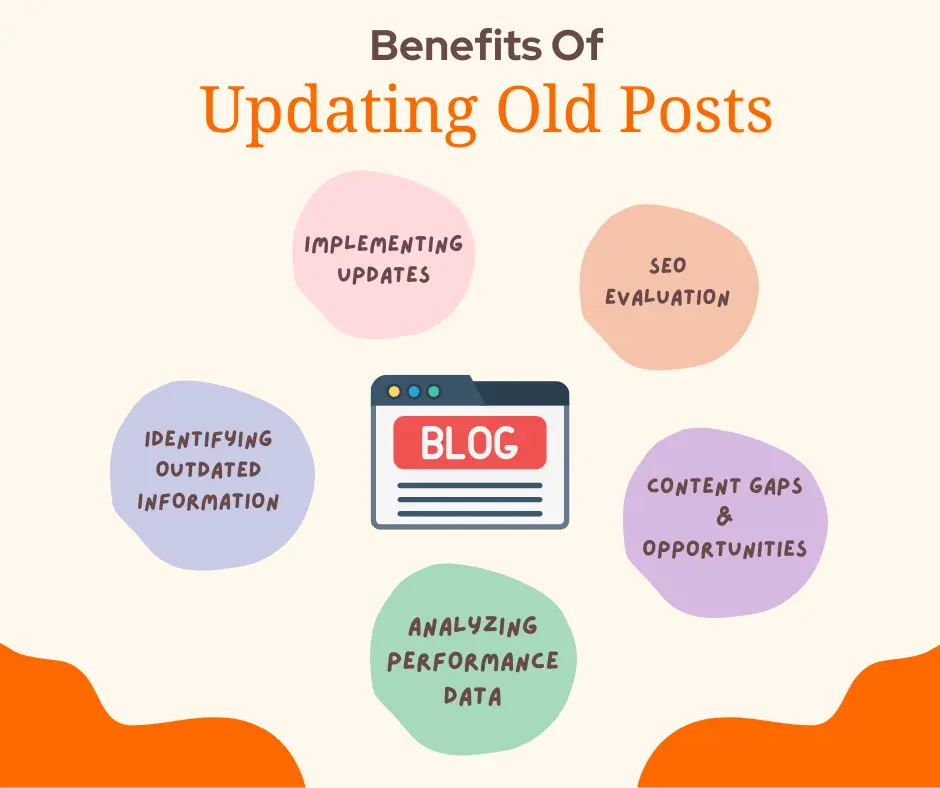Discover the secrets to revamping your blog posts for optimal SEO performance and watch your traffic soar to new heights!

Image courtesy of via DALL-E 3
Table of Contents
Introduction: Give Your Blog a Boost
Are you ready to breathe new life into your blog and attract more visitors? In this section, we will explore the concept of revitalizing your old blog posts through updates. By enhancing your content, you can improve your blog’s search engine optimization (SEO) and increase its popularity.
What Does It Mean to Revitalize a Blog?
Revitalizing a blog simply means giving your old posts a makeover. Just like giving your room a fresh coat of paint or updating your wardrobe, refreshing your blog content makes it more appealing and inviting. By updating your posts with new information, fixing any mistakes, and making them more engaging, you can attract more readers to your blog.
Why Updating Old Posts Is Important
Refreshing old posts is crucial for keeping your blog relevant and engaging. When you update your content, you show your readers that you care about providing them with accurate and up-to-date information. Additionally, search engines like Google love fresh content, so updating your posts can help improve your blog’s visibility online. Ready to revamp your blog and boost your SEO? Let’s get started!
Find the Posts That Need an Update
Before you start updating your old blog posts, it’s essential to figure out which ones need the most attention. Analytics tools can help you with that. These tools show you which posts are still getting a lot of views and which ones are not. You want to focus on updating the posts that are still popular to keep attracting visitors.
Looking for Outdated Information
Another way to find posts that need updating is to look for outdated or incorrect information. Sometimes, facts change, or new developments occur in a particular topic. By going through your older posts, you can identify any information that is no longer accurate and needs to be updated. This will ensure that your content remains reliable and up to date for your readers.
Researching New Content
When it comes to updating your old blog posts, one crucial aspect is researching new content to add value and relevance. By incorporating current information into your posts, you can attract more readers and improve your search engine rankings. Let’s dive into how you can effectively research new content.

Image courtesy of wtmarketing.com via Google Images
Finding Recent Trends
Researching recent trends is essential to keeping your blog posts up-to-date and engaging. You can start by exploring social media platforms, industry news websites, and Google Trends to identify popular topics. By incorporating these trends into your posts, you can ensure that your content remains relevant and interesting to your audience.
Using Reliable Sources
It’s crucial to use trustworthy sources when researching new content for your blog posts. Reliable sources can include reputable websites, scholarly articles, and industry experts. By citing credible sources, you not only add credibility to your content but also build trust with your readers. Remember, accuracy and reliability are key when it comes to sourcing information for your blog posts.
Rewrite and Improve Your Content
Updating your old blog posts doesn’t just mean changing a few words here and there. It’s about making them more engaging and interesting for your readers. Let’s dive into some tips on how to spruce up your content!
Making It Easy and Fun to Read
When rewriting your content, think about how you can make it more enjoyable for your audience to read. Use simple language and break up long paragraphs into shorter, digestible chunks. Adding a touch of humor or storytelling can also keep your readers entertained and wanting more.
Adding New Information
One way to enhance your old posts is by including new and relevant information. If you’ve found recent trends or data that relate to your topic, incorporate them into your content. This not only updates your post but also shows that you’re staying current and informed in your field.
Use Keywords Wisely
Keywords play a crucial role in helping your blog posts appear in search engine results. By using the right keywords effectively, you can increase the visibility of your content and attract more readers. Let’s dive into how to use keywords wisely to enhance your blog’s SEO.

Image courtesy of www.webceo.com via Google Images
What Are Keywords?
Keywords are specific words or phrases that people type into search engines when looking for information online. These words are essential because search engines match them with the content on websites to deliver relevant results to users. Choosing the right keywords related to your blog post topic is vital for improving your chances of being found by your target audience.
Inserting Keywords Naturally
When using keywords in your blog posts, it’s crucial to do so naturally. Stuffing your content with keywords can make it sound robotic and inauthentic, potentially turning off your readers. Instead, aim to incorporate keywords seamlessly into your writing. Focus on creating high-quality, engaging content that naturally includes the keywords you want to target.
Add Images and Videos
When it comes to adding images to your blog posts, it’s essential to select the right ones that complement your content. Images not only make your post more visually appealing but also help to break up large blocks of text, making it easier for readers to digest your content.
Consider using high-quality images that are relevant to your topic. If you’re writing a post about delicious recipes, include mouthwatering pictures of the dishes you’re discussing. The key is to choose images that enhance your message and engage your readers.
Including Helpful Videos
In addition to images, embedding videos in your blog posts can take your content to the next level. Videos can provide additional information, demonstrate a process, or simply entertain your audience. They can help keep readers engaged and increase the time they spend on your site.
Whether you create your own videos or find relevant ones on platforms like YouTube, make sure they add value to your post. If you’re writing a tutorial, a how-to video can be incredibly helpful. If you’re sharing a product review, include a video showcasing the product in action.
Link to Other Good Content
When you talk about linking to other good content, you’re essentially creating a pathway for your readers to discover more valuable information. Links act as signposts that guide your audience to related posts or pages that can enhance their understanding or provide additional insights. This not only benefits your readers but also boosts your blog’s search engine optimization (SEO) by showing search engines that your content is reputable and connected to other valuable resources.

Image courtesy of wtmarketing.com via Google Images
What Are Links?
Links are clickable elements within your text that direct the reader to another webpage, whether internal (within your own blog) or external (to another website). These hyperlinks are usually highlighted in a different color or underlined to distinguish them from regular text. They serve as bridges that connect different pieces of content, helping readers navigate through the vast web of information available online.
Linking to Your Own Posts
One of the best ways to keep readers engaged and nurture the growth of your blog is by linking to your own posts. By strategically placing links to related content within your blog, you encourage readers to explore more of your work. This not only increases the time they spend on your site but also improves the overall user experience. Additionally, internal linking helps search engines understand the structure of your website and the relevance of your content, boosting your SEO efforts.
Check for Errors and Publish
Before you share your updated blog post with the world, it’s crucial to make sure it is error-free and polished. Let’s dive into the final steps of the revitalization process.
Proofreading Tips
Proofreading is like giving your post a final check-up before sending it out into the digital universe. Here are some easy tips to help you catch any spelling or grammar errors:
- Read your post out loud to catch any awkward phrasing or mistakes.
- Use a spelling and grammar checker tool to flag any errors you might have missed.
- Ask a friend or family member to read over your post and provide feedback.
By taking the time to proofread your post, you’ll ensure that it’s clear, professional, and error-free before hitting that publish button.
Publishing Your Updated Post
Once you’ve proofread your post and made any necessary edits, it’s time to publish your updated content. Here’s a simple guide on how to finalize and share your improved blog post:
- Double-check all links in your post to make sure they are working correctly.
- Add relevant tags and categories to help readers find your post easily.
- Create an engaging meta description that summarizes your post and entices readers to click.
- Select a publish date and time that maximizes your post’s visibility and engagement.
- Hit that publish button and watch your revitalized blog post go live!
By following these steps, you’ll be able to share your updated content with confidence, knowing that you’ve put your best foot forward in the world of blogging.
Conclusion: Watch Your Blog Shine
In conclusion, by following the steps outlined in this blog, you can revitalize your blog and watch it shine with enhanced SEO. Updating old posts is a crucial strategy to attract more visitors, improve your search engine rankings, and keep your readers engaged. Remember, the key to a successful blog is to stay relevant and provide valuable content to your audience.

Image courtesy of www.singlegrain.com via Google Images
Summary of Steps
To recap, here are the essential steps to update your old posts for enhanced SEO:
1. Identify which posts need updating by utilizing analytics tools and checking for outdated information.
2. Research new and current information to add value to your posts, focusing on recent trends and using reliable sources.
3. Rewrite and improve your content by making it easy and fun to read, as well as by adding new information to keep your readers interested.
4. Use keywords wisely by understanding what keywords are, how they impact SEO, and how to naturally insert them into your posts.
5. Enhance your posts with images and videos that are relevant to your content, engaging, and visually appealing.
6. Link to other good content, both internal and external, to provide more value to your readers and improve your blog’s SEO.
7. Before publishing your updated post, remember to check for errors, proofread carefully, and ensure your content is error-free.
See the Positive Changes
By taking these steps to update your old posts, you will not only see improvements in your blog’s search engine visibility but also in reader engagement and overall success. Watch your blog shine as you continue to provide valuable and up-to-date content to your audience.
Want to turn these SEO insights into real results? Seorocket is an all-in-one AI SEO solution that uses the power of AI to analyze your competition and craft high-ranking content.
Seorocket offers a suite of powerful tools, including a Keyword Researcher to find the most profitable keywords, an AI Writer to generate unique and Google-friendly content, and an Automatic Publisher to schedule and publish your content directly to your website. Plus, you’ll get real-time performance tracking so you can see exactly what’s working and make adjustments as needed.
Stop just reading about SEO – take action with Seorocket and skyrocket your search rankings today. Sign up for a free trial and see the difference Seorocket can make for your website!
Frequently Asked Questions (FAQs)
Why Should I Update Old Posts?
Updating old posts is essential because it helps keep your blog relevant and up-to-date. By refreshing your content with new information, images, and keywords, you can attract more readers and improve your search engine rankings. Additionally, updating old posts shows that you care about providing accurate and valuable content to your audience.
How Often Should I Update a Post?
There is no set rule for how often you should update a post, as it depends on the content and your blogging schedule. However, it’s generally a good idea to revisit and refresh your posts every few months to ensure they remain current and engaging. Keep an eye on analytics to see which posts need the most attention.
What if I Don’t Have Time to Update All Posts?
If you find yourself short on time to update all your old posts, prioritize the ones that are most popular or have the highest potential for improvement. You can also create a schedule to gradually update posts over time, spreading out the workload and ensuring that all your content stays fresh and relevant.







